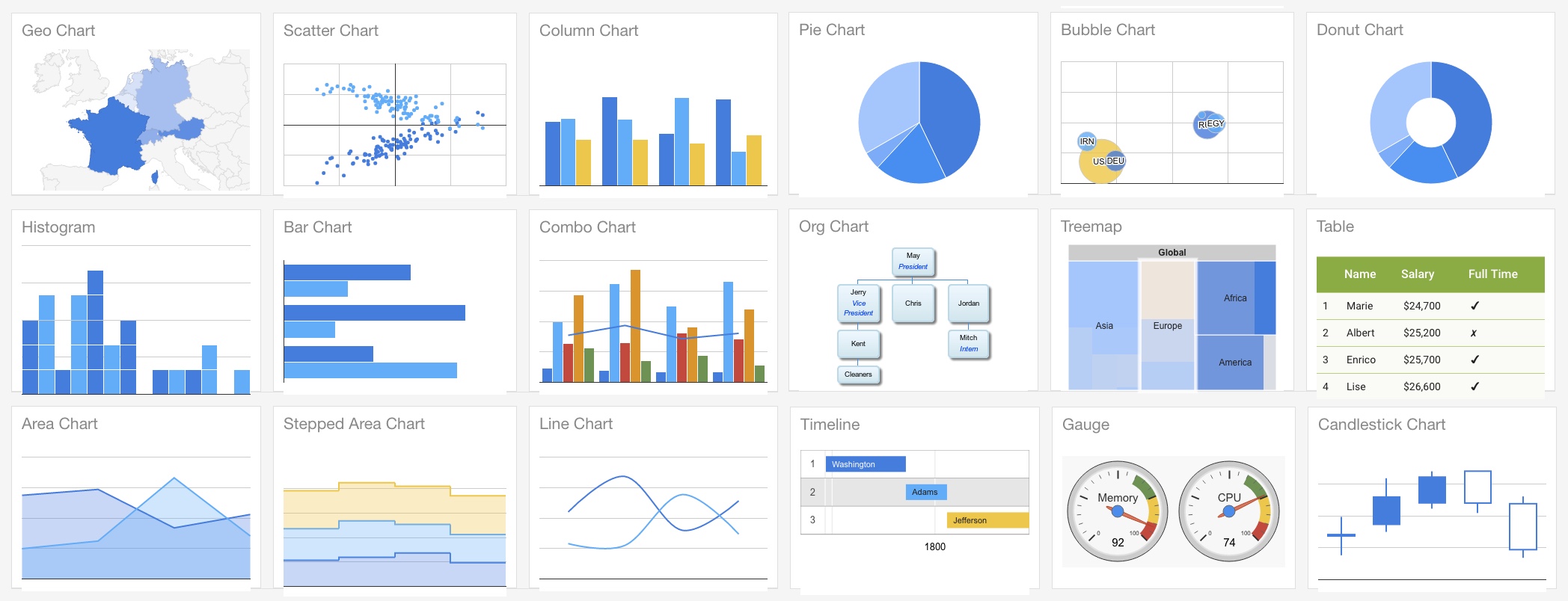Ember Google Charts makes it very easy to implement Google Charts in Ember CLI apps.
All dependencies are lazy loaded using the Google JS API Loader, which intelligently caches requests between a user's sessions.
ember install ember-google-chartsSee the demo app here.
There are six types of chart supported out of the box:
- Area Charts
- Bar Charts
- Geo Charts
- Line Charts
- Pie Charts
- Scatter Charts
To add a chart to any route, simply add the relevant component:
Data and options should be in the format expected by the given chart, as detailed in the Google Charts documentation.
For example:
/* stats/route.js */
import Ember from 'ember';
export default Ember.Route.extend({
model() {
return [
['Task', 'Hours per Day'],
['Work', 11],
['Eat', 2],
['Commute', 2],
['Watch TV', 2],
['Sleep', 7],
];
},
});/* stats/controller.js */
import Ember from 'ember';
export default Ember.Route.extend({
options: {
title: 'How I spend my days',
height: 300,
width: 400,
animation: {
startup: true,
easing: 'inAndOut',
},
},
});Where possible, this addon default to using Material Charts over Google's 'classic' design.
It's very easy to add non-default charts (e.g. table charts or gauge charts) - see the custom charts docs here
Default options for all charts can be set in the GoogleChartComponent. You can also set default options for individual charts, which will override the GoogleChartComponent default options.
Default options are always merged with the options you pass into a component. Passed in options will only override specific options properties, not the whole options object.
/* components/google-chart.js */
import GoogleChart from 'ember-google-charts/components/google-chart';
export default GoogleChart.extend({
defaultOptions: {
backgroundColor: '#389fcc',
annotations: {
alwaysOutside: true,
},
},
});You can set the language of the charts you render by specifying the language code in the google-charts service:
/* services/google-charts.js */
import GoogleChartsService from 'ember-google-charts/services/google-charts';
export GoogleChartsService.extend({
language: 'fr',
});For more information on locales, see the Google Charts documentaion.
Please note, Google Charts dependencies can only be loaded for a single language. This is a limitation of the Google API loader.
Two actions are available for you to hook on to:
This fires when the Google chart has rendered and is ready for interaction via Google Charts public methods.
This action receives the chart object of the rendered chart.
/* stats/controller.js */
import Ember from 'ember';
export default Ember.Controller.extend({
actions: {
selectCountry(chart) {
chart.setSelection('someValue');
},
},
});This fires when the Google chart has finished loading the required Google packages for a specific chart.
This action receives no params.
/* stats/controller.js */
import Ember from 'ember';
export default Ember.Controller.extend({
actions: {
checkGoogleExists() {
// Do something
},
},
});All chart components in this addon extend from a single core component: the GoogleChartComponent.
- Find the type of chart in the Google guides and see what Google Charts package it requires
- Update the Google Chart service
packagesproperty with the new Google Charts package you require (if applicable) - Use the
renderMaterialChartutil orrenderClassicChartutil (depending on what Google supports for the chart type) to write arenderChartfunction
/* components/gantt-chart.js */
import GoogleChart from 'ember-google-charts/components/google-chart';
import renderMaterialChart from 'ember-google-charts/utils/render-material-chart';
export default GoogleChart.extend({
type: 'gantt',
renderChart: renderMaterialChart,
});/* services/google-charts.js */
import GoogleChartsService from 'ember-google-charts/services/google-charts';
export GoogleChartsService.extend({
googlePackages: ['corechart', 'bar', 'line', 'scatter', 'gantt'],
});If preferred, you can write your own renderChart method. Use the renderMaterialChart util as your guide.
renderChart receives the chart data and options as params and it must return a promise that resolves with the chart object (resolve(chart)).
You will need to add the following to your app's content security policy to mitigate CSP errors:
contentSecurityPolicy: {
'script-src': "'self' 'unsafe-eval' *.google.com *.gstatic.com",
'style-src': "'self' 'unsafe-inline' *.google.com *.googleapis.com *.gstatic.com",
'font-src': "'self' *.gstatic.com *.googleapis.com",
}All PRs and issues are welcome.
git clone https://github.com/sir-dunxalot/ember-google-charts.gitcd ember-tooltipsnpm install && bower installember sember test,ember try:testall, or the/testsroute
Please include tests and documentation updates with any new features.
You do not need to bump the version when you have a PR.
To release an update to the demo app:
git checkout master # make sure you're on master branch
ember github-pages:commit --message "Some commit message" # Builds the app
git push origin gh-pages:gh-pages # Deploys the app
